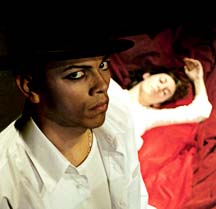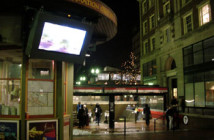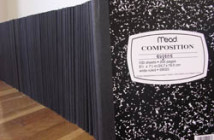Here in town this summer, Company One staged their take on Anthony Burgess’s A Clockwork Orange. The play, modified from Burgess’s own stage play, was produced at the Boston Center for the Arts. Company One billed it as an experience that would propel viewers into a “shockingly tantalizing exploration of the meaning of free will and the conflict between good and evil.” Actually, the particulars of the Company One production seemed to me to make for a kind of mid-summer hometown zeitgeist.
1. Boston’s own ornamental rock band, the Dresden Dolls (Amanda Palmer and Brian Viglione) improvised mood music for the stage production in short order.
2. Company One even employed a “brutality consultant,” the very NOT BORING Alisia Waller. Also, a fight director and an assistant fight director.
3. Blocks away from the BCA, the Democratic National Convention was in town, featuring fallaciously omniscient media coverage (I am thinking of the cameras panning manically over conventioneers; during Barrack Obama’s speech, there were constant close-ups on black delegates and Hilary Clinton). Thus, when Brian Quint, as the play’s Minister of the Interior, wore an American flag, the play was positioned squarely within this town’s atmosphere of extravaganza.
4. Also blocks away, an 11-year-old boy was shot in the chest in daylight at a baseball tryout in a park off Columbus Avenue, just one half hour after the play I attended began.
How long do you think the shelf life of the shock in a shocking thing is? In 1972 and 73, copycat Clockwork Orange crimes went off all over the United Kingdom. The film also influenced a 22-year-old American named Arthur Bremer. In 1972, Bremer shot at George Wallace, the controversial politician and presidential hopeful. Bremer named his cinematic influence in his published diary, using a familiar, borrowed patois:
Saw Clockwork Orange & thought about getting Wallace all thru the picture—fantasing my self as the Alek on the screen come to real life—but without “my brothers” & without any “in and out.” Just “a little of the old ultra violence.”
A clip from THAT incident’s real-life media flap was included in 1994’s Forrest Gump. Martin Scorcese’s film Taxi Driver was inspired by the Arthur Bremer story. And it was repeated viewings of Taxi Driver that seemed to crystallize John Hinckley Jr.’s plans to assassinate Ronald Reagan in the name of his love for Jodie Foster.
So it seems that the beat of the real artistic horror show goes on.
Stanley Kubrick’s landmark interpretation of A Clockwork Orange is not a summer film. Women are raped but no one sweats. Men are pummeled but no one pants. Its synthetic stylishness is icy. The film was a January release. (And within a year of the wide release, Kubrick had voluntarily pulled the film from distribution in Britain.)
Was this play at this time a shock to watch? We-ell, it was not tantalizingly metaphysical. Despite all of Burgess’s AND Kubrick’s claims of what they were up to, on a cosmic scale, I don’t think that A Clockwork Orange engages full on the questions of good, evil, and how free will fits into it all. Maybe the problem is that Burgess, and Kubrick, undermine the moral voice of A Clockwork Orange by making it a voice that comes from the tippling prison chaplain (after, say, 1960, any character designated as a Man of the Cloth automatically abounds with irony). The charge of A Clockwork Orange is the ultra in the ultra violence, the glamour of it all. Musing on Burgess’s version of a dystopia is not nearly so intriguing. His tragedy is rather that “Alex, whose sweet and juicy criminality, which he thoroughly enjoys, is expunged by a course of conditioning in which he loses the free will which enables him to be a thug—but also, if he wishes, a decent adolescent with a strong musical talent.” This does not seem a thing to mourn.
Company One’s interpretation of A Clockwork Orange was, at close vantage, quite good. Alex, played by the 19-year-old Raymond Ramirez, was puckish enough that his character’s ravages were equal parts stylish and depraved. The staging and costumes felt muscular and vigorous. Company One played the Chaplain differently than Kubrick. Their chaplain, played by Brian Fahey, was all camped up. He was in white face and wore tiny, lipsticked mime’s lips, and boa of faux animal pelts. Thus, as the lone voice speaking out against Alex’s Ludovico reprogramming, the Chaplain speaks with a weary insouciance that comes from a “flamed out” conscience (if you catch their drift). Further, the play’s Guard had a short necked, Southie guy feel to him which offered a different spin on the ‘just doin’ my job’ schtick. This was a more pugilistic and less ludicrous motivation to enforce the penal system laws. In the play, the guard’s brand of brutality matched Alex’s brand of brutality in a one-to-one correspondence.
But that was all on stage. I doubt that a stage production has ever spawned a copycat crime. For example, the sound of real bodies moving about will always be keenly present in live theatre. Percussion is on a human scale. Company One’s droogs wore chains around their pants ankles that jangled at any sudden move. In the rape scene, Amanda Palmer’s piano breaks into the sound of F. Alexander’s compulsive typing, first tentatively then more authoritatively. Her trademark noodling mediates a rickety Beethoven’s Ninth. Alex euphorically conducts the breaks of this wandering music while he spreads Mrs. Alexander’s legs. The lights go black.
A Clockwork Orange on stage at the BCA was, in sum, not at all shocking.
Remember how there is basically no blood in Kubrick’s A Clockwork Orange? (There is just one instance, when Alex administers a surface wound on Dim’s hand.) Company One used no blood effects either. Its real people in real time did not bleed. Fights were often represented by a blade drawn across the groin area and those repeated gang scenes were effectively really weirdly erotic. Maybe this summer (as I assembled it across my four talking points at the start) is the summer of the white, chalky face. These Boston spectacles are really effectively Brechtian, thank you Dresden Dolls. Our cultural commentators split the hair of each production value. Our government claims to address, head on, the presence of Evil (a kind of Evil that can never be rehabilitated and must be rooted out.) The fact of rape remains unfathomable. But a ‘fact’ is frustratingly linguistic and no matter how graphic a filmmaker or violence consultant gets, rape is brutally internal. Its mechanics are invisible. I have no idea what I was looking to see shock me on stage but all I felt was a kind of moral malaise.
Before Alex makes his suicide attempt, driven to it by the despair the loss of his passion for Beethoven (and the powerfully blunting waves of nausea he is programmed to experience), he rips off his shoulder armor and clutches the foam padding to his ears in agony. Meanwhile, the woman on the cover of the Boston Phoenix (DNC edition) ADULT section wore star spangled kneepads: the perfectly chilled punctuation to Company One’s concurrent production.
Kneepads! There must be something shockingly topical, here.
Links:
Company One
The Boston Center for the Arts
The Dresden Dolls
A Clockwork Orange Timeline
"A Clockwork Orange" played through August 14 at the Boston Center for the Arts, 539 Tremont Street, Boston
Images are courtesy of Company One and Kelly Davidson
Anneka Lenssen is a Boston based writer and is currently pursuing a master's degree in art history.
Anneka is a new contributor to Big, Red & Shiny.




